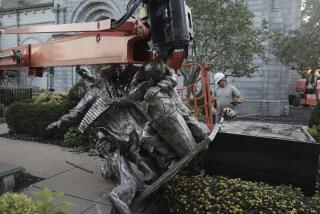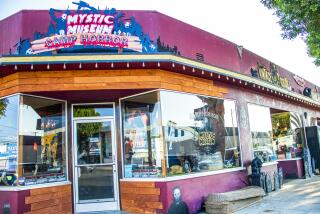Masterpiece Is Stolen From a Vienna Museum
- Share via
VIENNA — Climbing scaffolding and smashing a window early Sunday, thieves slipped into Vienna’s Art History Museum and -- despite high-tech motion sensors and round-the-clock guards -- disappeared with a 16th century gold masterpiece sculpted by Benvenuto Cellini.
The stealthy and stunning heist was one of the biggest art thefts in Europe in recent years. The intricate, 10-inch-high sculpture, known as the Saliera, or salt cellar, is valued at about $57 million. It was commissioned from Cellini -- an outlaw himself and one of the Italian Renaissance’s most ingenious goldsmiths -- in the 1540s by King Francois I of France.
Museum director Wilfried Seipel called the piece the “Mona Lisa of sculptures.” Police in the Austrian capital said one or more thieves crawled through a broken second-floor window at 4 a.m., shattered the heavy-glass display case around the Saliera, grabbed the sculpture and fled. Police were investigating whether the robbery might have been an inside job. The museum’s alarms did go off, and all the artwork was protected by motion sensors and video cameras. The theft was discovered at 8:20 a.m. when a museum porter noticed the damage.
“The alarm was activated,” Seipel told the Austrian TV network, ORF. “Why this wasn’t reacted to in good time and as quickly as possible is being investigated at the moment. We had to release the three employees [guards] from work for the time being.”
The thieves knew what they wanted and were most likely contracted, said Guenther Fuchs, an Austrian police spokesman. A valuable Raphael painting hanging next to the Saliera was left untouched, and no other artworks vanished from the museum -- called in German the Kunsthistorisches -- which houses one of the best collections of classical art in Europe.
“You can’t sell the Saliera on the art market, so we are assuming that the theft was ordered by someone,” Fuchs said. Austrian authorities have contacted Interpol, and the museum is offering an $80,000 reward for information leading to the arrest of the thieves and the recovery of the sculpture.
Seipel told the Austrian Press Agency that the thief was “either a crazy who saw the piece in an exhibition and wanted it for himself, or somebody who is looking to extort money. Hopefully no one gets the idea to melt it down.”
The Saliera is an example of the delicate, finely articulated style of Renaissance art.
Merging gold, enamel and ebony, it depicts a bearded man with a trident, symbolizing the sea, leaning back and resting upon the head of a horse. The man stares at a woman, symbolizing the Earth, whose legs are intertwined with his. The piece, according to art historians, is both a royal salt holder and “an allegorical representation of planet Earth.”
Cellini was not only a master sculptor in gold and other media. He was prone to mystical trances and was a wordsmith too. His “Autobiography” is self-promoting and laced with exaggeration, but in the words of an Italian state-sponsored art Web site, it “remains a cornerstone of Italian literature.”
Cellini wrote this about the Saliera: “In order to show how the sea is connected with the Earth, I made two figures.... The sea, depicted as a man, holds a richly decorated ship.... The Earth, I depict as a woman, of such lovely form and as graceful as I knew how to create. Next to her I placed on the ground a richly decorated temple, which was intended to hold pepper.”
When Cellini wasn’t tinkering with gold, or casting bronze, he was running from the law.
He was wanted for beating people he didn’t like, for the revenge killing of his brother’s murderer and for “being condemned for sodomy,” according to the Italian Web site.
He died in 1571 in Florence and is buried in the Church of Santa Maria Novella in the central Italian city.
*
Fleishman reported from Berlin and Yee from Vienna.
More to Read
The biggest entertainment stories
Get our big stories about Hollywood, film, television, music, arts, culture and more right in your inbox as soon as they publish.
You may occasionally receive promotional content from the Los Angeles Times.











